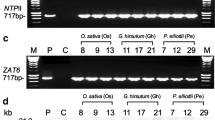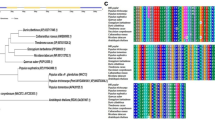Abstract
Osmotin promoter binding protein 1 (OPBP1), an AP2/EREBP-like transcription factor of tobacco (Nicotiana tabacum), was isolated using a yeast one-hybrid system. RNA gel blot analysis indicated that expression of the OPBP1 gene was induced by elicitor cryptogein, NaCl, ethephon, methyl jasmonate, as well as cycloheximide. Transient expression analysis using an OPBP1-eGFP fusion gene in onion epidermal cells revealed that the OPBP1 protein was targeted to the nuclear. Further, electrophoretic mobility shift assays demonstrated that the recombinant OPBP1 protein could bind to an oligonucleotide containing the GCC-box cis element. Transgenic tobacco plants with an over expression of the OPBP1 gene accumulated high levels of PR-1a and PR-5d genes and exhibited enhanced resistance to infection by Pseudomonas syringae pv tabaci and Phytophthora parasiticavar nicotianae pathogens. They also exhibited increased tolerance to salt stress. These results suggest that OPBP1 might be a transcriptional regulator capable of regulating expression in sets of stress-related genes.
Similar content being viewed by others
References
Aono, M., Kubo, A., Saji, H., Tanaka, K. and Kondo, N. 1993. Enhanced tolerance to photooxidative stress of transgenic Nicotiana tabacum with high chloroplastic glutathione reductase activity. Plant Cell Physiol. 34: 129–136.
Bertoni, G. and Mills, D. 1987. A simple method to monitor growth of bacterial population in leaf tissue. Phytopathology 77: 832–835.
Buttner, M. and Singh, K.B. 1997. Arabidopsis thaliana ethylene-responsive element binding protein (AtEBP) and ethylene-inducible, GCC box DNA-binding protein interact with an ocs element binding protein. Proc. Natl. Acad. Sci. USA 94: 5961–5966.
Cormack, R.S., Eulgem, T., Rushton, P.J., Kochner, P., Hahlbrock, K. and Somssich, I.E. 2002. Leucine zippercontaining WRKY proteins widen the spectrum of immediate early elicitor-induced WRKY transcription factors in parsley. Biochim. Biophysi Acta 1576: 92–100.
Gong, Z., Koiwa, H., Cushman, M.A., Ray, A., Bufford, D., Kore-eda, S., Matsumoto, T.K., Zhu, J., Cushman, J.C., Bressan, R.A. and Hasegawa, P.M. 2001. Genes that are uniquely stress regulated in salt overly sensitive (sos) mutants. Plant Physiol. 126: 363–375.
Gu, Y.Q., Yang, C., Thara, V.K., Zhou, J. and Martin, G.B. 2000. Pti4 is induced by ethylene and salicylic acid, and its product is phosphorylated by the Pto kinase. Plant Cell 12: 771–785.
Hill, C.S. and Treisman, R. 1995. Transcriptional regulation by extracellular signals: mechanisms and specificity. Cell 80: 199–211.
Hasegawa, P.M., Bressan, R.A., Zhu, J.-K. and Bohnert, H.J. 2000. Plant cellular and molecular responses to high salinity. Ann. Rev. Plant Physiol. Plant Mol. Biol. 51: 463–499.
Hoekema, A., Hirsch, P., Hooykaas, P.J.J. and Schilperootm, R. 1983. A binary plant vector strategy based on separation of vir-and T-region of the Agrobacterium tumefaciens Ti-plasmid. Nature 303: 179–180.
Ingram, J. and Bartels, D. 1996. The molecular basis of dehydration tolerance in plants. Ann. Rev. Plant Physiol. Plant Mol. Biol. 47: 377–403.
Jiang, D.-H., Guo, Z.-J. and Zheng, Z. 2002. Site-directed mutagenesis of cryptogein gene and generation of transgenic tobacco plants with nonspecific disease resistance. J. Plant Physiol. Mol. Biol. 28: 399–406. (in Chinese with English abstract)
Jofuku, K.D., den Boer, B.G.W., Van Montagu, M. and Okamura, J.K. 1994. Control of Arabidopsis flower and seed development by the homeotic gene APETALA2. Plant Cell 6: 1211–1225.
Kasuga, M., Liu, Q., Miura, S., Yamaguchi, K. and Shinozaki, K. 1999. Improving plant drought, salt, and freezing tolerance by gene transfer of a single stress-induced transcription factor. Nat. Biotechnol. 17: 287–291.
Kirsten, R., Jaglo-Ottosen, S.J., Gilmour, D.G., Zarka, O.S. and Thomashow, M.F. 1998. Arabidopsis CBF1 overexpression induces COR genes and enhances freezing tolerance. Science 280: 104–106.
Kitajima, S., Koyama, T., Yamada, Y. and Sato, F. 1998. Constitutive expression of the neutral PR-5 (OLP, PR-5d) gene in roots and cultured cells of tobacco is mediated by ethylene-responsive cis-element AGCCGCC sequences. Plant Cell Report 18: 173–179.
Koshiba, T., Ballas, N., Wong, L.M. and Theologis, A. 1995. Transcriptional regulation of PS-IAA4/5 and PS-IAA6 early gene expression by indoleacetic acid and protein synthesis inhibitors in pea (Pisum ativum). J. Mol. Biol. 253: 396–413.
Lebrun-Garcia, A., Chiltz, A., Gout, E., Bligny, R. and Pugin, A. 2002. Questioning the role of salicylic acid and cytosolic acidification in mitogen activated protein kinase (MAPK) activation induced by cryptogein in tobacco cells. Planta 214: 792–797.
Leccourieux-Ouaked, F., Pugin, A. and Lebrun-Garcia, A. 2000. Phosphoproteins involved in the signal transduction of cryptogein, an elicitor of defense reactions in tobacco. Mol. Plant-Microbe Interact. 13: 821–829.
Li, Q., von Lanken, C., Yang, J., Lawrence, C.B. and Hunt, A.G. 2000. The yeast polyadenylate binding protein (PAB1) gene acts as a disease lesion mimic gene when expressed in plants. Plant Mol. Biol. 42: 335–344.
Liu, Q., Kasuga, M., Sakuma, Y., Abe, H., Miura, S., Yamaguchi-Shinozaki, K. and Shinozaki, K. 1998. Two transcription factors, DREB1 and DREB2, with an EREBP/AP2 DNA binding domain separate two cellular signal transduction pathways in drought-and low-temperature-responsive gene expression, respectively, in Arabidopsis. Plant Cell 10: 1391–1406.
Lorenzo, O., Piqueras, R., Sanchez-Serrano, J.J. and Solano, R. 2003. Ethylene response factor1 integrates signals from ethylene and jasmonate pathways in plant defense. Plant Cell 25: 165–178.
Murashige, T. and Skoog, F. 1962. A revised medium for rapid growth and bioassays with tobacco tissue culture. Physiol Plant 15: 473–497.
Nakai, K. and Kanehisa, M. 1992. A knowledge base for predicting protein localization sites in eukaryotic cells. Genomics 14: 897–911.
Ohme-Takagi, M. and Shinshi, H. 1995. Ethylene-inducible DNA binding proteins that interact with an ethyleneresponsive element. Plant Cell 7: 173–182.
Okamuro, J.K., Caster, B., Villarroel, R., van Montagu, M. and Jofuku, K.D. 1997. The AP2 domain of APETALA2 defines a large new family of DNA binding proteins in Arabidopsis. Proc. Natl. Acad. Sci. USA 94: 7076–7081.
Park, J.M., Park, C.J., Lee, S.B., Ham, B.K., Shin, R. and Paek, K.H. 2001. Overexpression of the tobacco Tsi1 gene encoding an EREBP/AP2-type transcription factor enhances resistance against pathogen attack and osmotic stress in tobacco. Plant Cell 13: 1036–1046.
Raghothama, K.G., Maggio, A., Narasimhan, M.L., Kononowicz, A.K., Wang, G., Paino D'Urzo, M., Hasegawa, P.M. and Bressan, R.A. 1997. Tissue-specific activation of the osmotin gene by ABA, C2H4 and NaCl involves the same promoter region. Plant Mol. Biol. 34: 393–402.
Riechmann, J.L., Heard, J., Martin, G., Reuber, L., Jiang, C.-Z., Keddie, J., Adam, L., Pineda, O., Ratcliffe, O.J., Samaha, R.R., Creelman, R., Pilgrim, M., Broun, P., Zhang, J.Z., Ghandehari, D., Sherman, B.K. and Yu, G.-L. 2000. Arabidopsis transcription factors: Genome-wide comparative analysis among eukaryotes. Science 290: 2105–2110.
Rushton, P.J., Torres, J.T., Parniske, M., Wernert, P., Hahlbrock, K. and Somssich, I.E. 1996. Interaction of elicitorinduced DNA binding proteins with elicitor response elements in the promoters of parsley PR1genes. EMBO J. 15: 5690–5700.
Sambrook, J., Fritsch, E.F. and Maniatis, T. 1989. Molecular Cloning: A Laboratory Manual, 2nd ed. Cold Spring Harbor Laboratory Press, Plainview, NY.
Shen, S., Li, Q., He, S.-Y., Barker, K.R., Li, D. and Hunt, A.G. 2000. Conversion of compatible plant-pathogen interactions into incompatible interactions by expression of the Pseudomonas syringae pv. syringae 61 hrmA gene in transgenic tobacco plants. Plant J. 23: 205–213.
Shinozaki, K. and Yamaguchi-Shinozaki, K. 1997. Gene expression and signal transduction in water-stress response. Plant Physiol. 115: 327–334.
Solano, R., Stepanova, A., Chao, Q. and Ecker, J.R. 1998. Nuclear events in ethylene signaling: a transcriptional cascade mediated by ETHYLENE-INSENSITIVE3 and ETHYLENE-RESPONSE-FACTOR1. Genes Dev. 12: 3703–3714.
Stockinger, E.J., Gilmour, S.J. and Thomashow, M.F. 1997. Arabidopsis thaliana CBF1 encodes an AP2 domain-containing transcriptional activator that binds to the C-repeat/DRE, a cis-acting DNA regulatory element that stimulates transcription in response to low temperature and water deficit. Proc. Natl. Acad. Sci. USA 94: 1035–1040.
Suziki, K., Suziki, N., Ohme-Takagi, M. and Shinshi, H. 1998. Immediate early induction of mRNAs for ethylene-responsive transcription factors in tobacco leaf strips after cutting. Plant J. 15: 657–665.
van der Fits, L. and Memelink, J. 2001. The jasmonateinducible AP2/ERF-domain transcription factor ORCA3 activates gene expression via interaction with a jasmonateresponsive promoter element. Plant J. 25: 43–53.
Varagona, M.J., Schmidt, R.J. and Raikhel, N.V. 1992. Nuclear localization signal(s) required for nuclear targeting of the maize regulatory protein opaque-2. Plant Cell 4: 1213–1227.
Wilson, K., Long, D., Swinburne, J. and Coupland, G. 1996. A dissociation insertion causes a semidominant mutation that increases expression of TINY, an Arabidopsis gene related to APETALA2. Plant Cell 8: 659–671.
Xu, P., Ling, J.Q., Li, D.B., Hasegawa, P.M. and Bressan, R.A. 1998. Identification of a novel DNA-binding protein to osmotin promoter. Sci. China (Series C) 41: 657–663.
Xu, Y., Chang, P.-F., Liu, D., Narasimhan, M.L., Raghothama, K.G., Hasegawa, P.M. and Bressan, R.A. 1994. Plant defense genes are synergistically induced by ethylene and methyl jasmonate. Plant Cell 6: 1077–1085.
Yang, Y., Shah, J. and Klessig, D.F. 1997. Signal perception and transduction in plant defense responses. Gene Dev. 11: 1621–1639.
Zhou, J., Tang, X. and Martin, G.B. 1997. The Pto kinase conferring resistance to tomato bacterial speck disease interacts with proteins that bind a cis-element of pathogenesis-related genes. EMBO J. 16: 3207–3218.
Zhu, J.-K., Hasegawa, P.M. and Bressan, R.A. 1997. Molecular aspects of osmotic stress in plants. Crit. Rev. Plant Sci. 16: 253–277.
Author information
Authors and Affiliations
Rights and permissions
About this article
Cite this article
Guo, ZJ., Chen, XJ., Wu, XL. et al. Overexpression of the AP2/EREBP transcription factor OPBP1 enhances disease resistance and salt tolerance in tobacco. Plant Mol Biol 55, 607–618 (2004). https://doi.org/10.1007/s11103-004-1521-3
Issue Date:
DOI: https://doi.org/10.1007/s11103-004-1521-3




